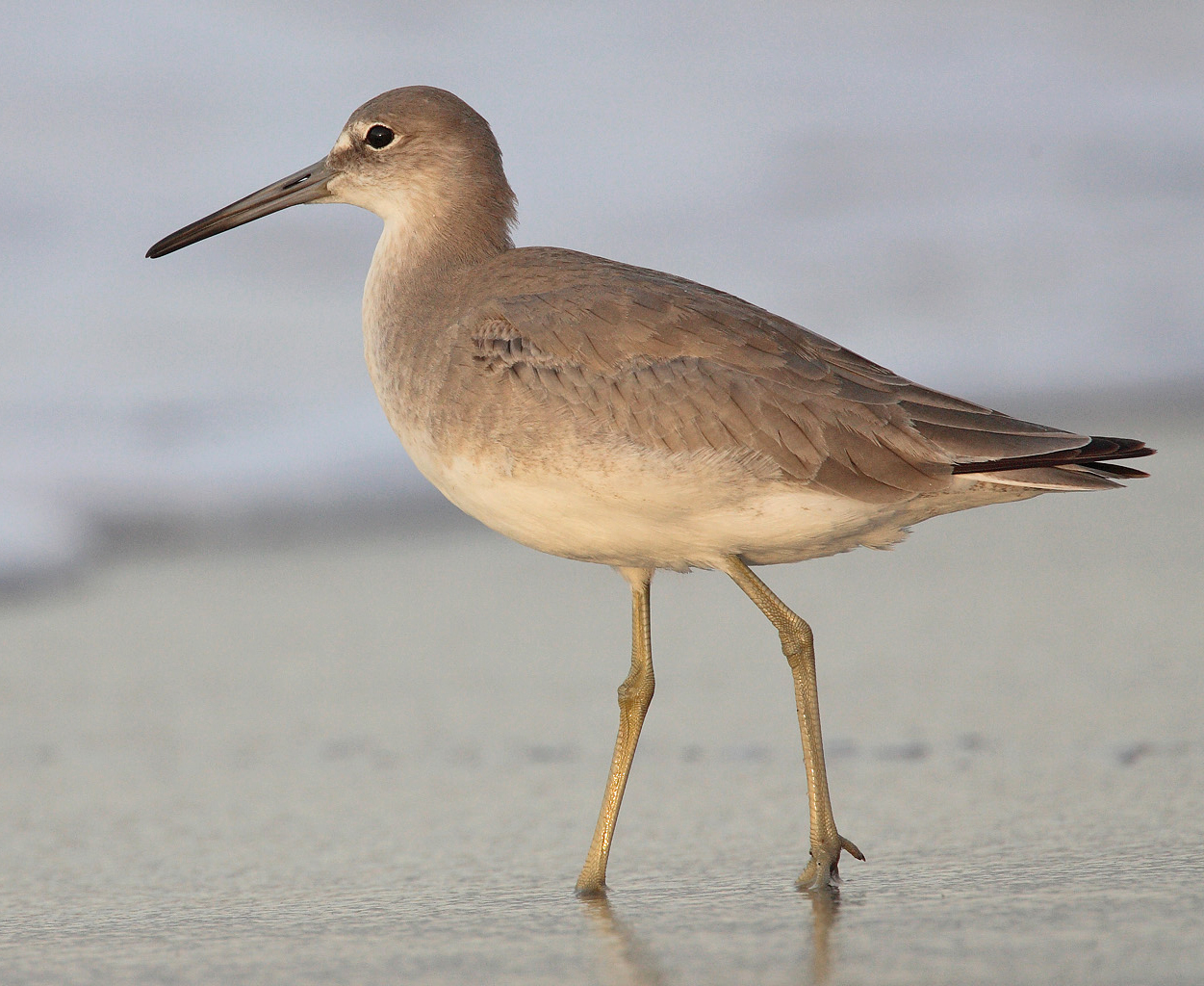- Willet
"Taxobox
name = Willet
status = LC | status_system = IUCN3.1

image_width = 256px
regnum =Animal ia
phylum = Chordata
classis = Aves
ordo =Charadriiformes
familia =Scolopacidae
genus = "Tringa "
species = "T. semipalmata"
species_authority =
binomial = "Tringa semipalmata"
subdivision_ranks =Subspecies
subdivision =
* "T. s. semipalmata" Eastern Willet
* "T. s. inornata" Western Willet
synonyms ="Catoptrophus semipalmatus"
"Totanus semipalmatus"The Willet, "Tringa semipalmata" (formerly in the
monotypic genus "Catoptrophorus", as "Catoptrophorus semipalmatus" [Pereira & Baker (2005), Banks "et al." (2006)] ), is a largeshorebird in thesandpiper family. It is a well-sized and stout scolopacid, the largest of theshanks . Its closest relative is theLesser Yellowlegs , a much smaller bird with a very different appearance apart from the fine, clear and dense pattern of the neck which both species show in breeding plumage.Adults have gray legs and a long, straight, dark and stout bill. The body is dark gray above and light underneath. The tail is white with a dark band at the end. The distinctive black and white pattern of the wings is a common sight along many North American coastal beaches.
Two subspecies (which may well be different speciesFact|date=February 2007) have very different breeding habitats and ranges. The Eastern Willet breeds in coastal saltmarshes from
Nova Scotia to Mexico and the Caribbean. It winters on the Atlantic coast of South America. The Western Willet breeds in freshwater prairie marshes in westernNorth America . It winters on both coasts, from the mid-Atlantic states south to at least Brazil on the Atlantic, and from Oregon south to Peru on the Pacific.Willets nest on the ground, usually in well-hidden locations in short grass, often in colonies. These birds forage on mudflats or in shallow water, probing or picking up food by sight. They mainly eat insects, crustaceans and marine worms, but also eat some plant material.
The willet's population declined sharply due to hunting in the late nineteenth and early twentieth centuries. Their population has since increased, but they are still considered at risk, especially in light of continued habitat loss.
Footnotes
References
* Banks, Richard C.; Cicero, Carla; Dunn, Jon L.; Kratter, Andrew W.; Rasmussen, Pamela C.; Remsen, J. V. Jr.; Rising, James D. & Stotz, Douglas F. (2006): Forty-seventh Supplement to the American Ornithologists' Union Check-list of North American Birds. "Auk" 123(3): 926–936. DOI: 10.1642/0004-8038(2006)123 [926:FSTTAO] 2.0.CO;2 [http://www.aou.org/checklist/Suppl47.pdf PDF fulltext]
* Database entry includes justification for why this species is of least concern
* Pereira, Sérgio Luiz & Baker, Alan J. (2005): Multiple Gene Evidence for Parallel Evolution and Retention of Ancestral Morphological States in the Shanks (Charadriiformes: Scolopacidae). "Condor" 107(3): 514–526. DOI: 10.1650/0010-5422(2005)107 [0514:MGEFPE] 2.0.CO;2 [http://www.bioone.org/perlserv/?request=get-abstract&issn=0010-5422&volume=107&issue=03&page=0514 HTML abstract]
External links
* Connecticut
Department of Environmental Protection : [http://dep.state.ct.us/burnatr/wildlife/factshts/willet.htm Wildlife in Connecticut - Endangered and Threatened Species Series: Willet]
* [http://www.birds.cornell.edu/AllAboutBirds/BirdGuide/Willet.html Willet Species Account] - Cornell Lab of Ornithology
* [http://www.sdakotabirds.com/species/willet_info.htm Willet Information and Photos] - South Dakota Birds and Birding
* [http://www.mbr-pwrc.usgs.gov/id/framlst/i2580id.html Willet - "Catoptrophorus semipalmatus"] - USGS Patuxent Bird Identification InfoCenter
Wikimedia Foundation. 2010.
